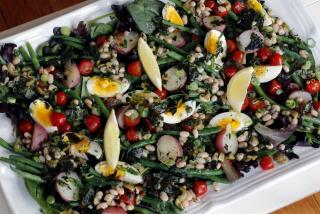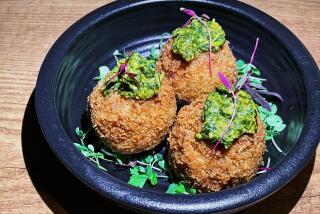Macro is getting all, well, macro
- Share via
Macrobiotic living -- a one-with-nature philosophy heavy on the whole grains and vegetables -- is riding the wave of interest in organic and healthy foods to new popularity.
The macrobiotic diet, part of a greater doctrine of living a happy, healthy life in harmony with the environment, was brought to the U.S. in the 1950s by Japanese philosopher George Ohsawa, and has cycled in and out of fashion ever since. Right now, it is riding high -- Los Angeles has even seen the opening of several new macrobiotic restaurants in recent months.
“My phone’s ringing more, students are showing up for classes more,” says David Briscoe, a macrobiotic consultant and co-founder of Macrobiotics America in Oroville. “It’s definitely an increasing trend.”
Practitioners credit their diet for preventing diseases including colds and cancer. “Our kitchen is our pharmacy,” says Mina Dobic, a macrobiotic counselor and state-certified nutritional advisor in Los Angeles. “When you eat well and you also live well, then you live a longer life.”
Dobic’s personal enthusiasm for macrobiotic food dates back 22 years, to the time when she was diagnosed with cancer and, she says, given two months to live. She credits macrobiotic living for her recovery and subsequent stellar health -- not a single cold in two decades, she says.
But to suggest macrobiotics is a panacea is a step too far, says Andrea Giancoli, a registered dietitian in Los Angeles and a spokeswoman for the American Dietetic Assn. It does, however, have healthful features -- it is high in fiber and low in saturated fat and cholesterol. A diet packed with vegetables, fruits and whole grains is associated with reduced risk for heart disease and some cancers, according to the American Heart Assn. and American Cancer Society.
Macrobiotics categorizes foods as “expansive” or “contractive” -- the yin and yang, respectively, of macrobiotic eating. Cool, fresh expansive foods (such as apples) enhance relaxation; warm, salted contractive foods (such as fish) promote focus. Getting too much of one or the other can imbalance the body, Briscoe says, leading to health problems.
The primary macrobiotic prescription: whole grains. Vegetables and plant-based proteins, such as beans and soy products, are also key. The diet deemphasizes acid-forming foods such as dairy products.
Vegan principles -- no animal products at all -- are a common complement but not required; many macrobiotic menus include the occasional fish dish.
Macrobiotics’ Asian origins also show in the recommended foods. Seaweed, high in minerals, is an essential component. Miso soup, made from a paste of fermented beans and grains, is also a top macrobiotic choice. Miso is the “bodyguard of the immune system,” Dobic says.
Some research suggests that elements of the macrobiotic diet may have cancer- and infection-fighting properties, says Jane Teas, who studies seaweed and cancer at the University of South Carolina in Columbia.
For example, in a 2001 study, Japanese scientists found that a seaweed extract suppressed breast tumor growth in rats and caused human breast cancer cells growing in a dish to commit cellular suicide. Another Japanese research group has reported that a starch from algae has antiviral properties and prevented death in mice infected with the influenza virus.
“In my opinion, in 20 years seaweed will be part of that dietary pyramid,” Teas says.
Collecting data to link macrobiotics to cancer prevention or treatment in humans is difficult, Teas adds. That’s because people interpret the tenets of macrobiotics in a variety of ways. When she interviewed macrobiotic eaters for one study, “the range of what people said was macrobiotics was incredible.” That variability, combined with the fact that the population of macrobiotics followers is small, makes rigorous scientific study challenging.
Though a macrobiotic diet includes many healthy characteristics, it isn’t the only diet that has those advantages. And Giancoli has a few reservations about macrobiotic eating. Macrobiotics recommends that people minimize members of the nightshade family, such as tomatoes and potatoes, as well as many fruits because of their sugar content. “That’s just silly,” Giancoli says. “People shouldn’t be afraid of fruit.”
People considering a macrobiotic diet, particularly if they are vegan, should be careful about getting enough vitamin B-12, which is found only in animal products. After giving up meat and dairy, a person can live off the body’s B-12 stores for five or six years, Giancoli says, but eventually supplements would be advisable. The U.S. government recommends adults get 2.4 micrograms of vitamin B-12 daily.
In many ways, macrobiotics has been ahead of the curve, says Lawrence Kushi, a cancer epidemiologist at Kaiser Permanente Northern California in Oakland. The son of macrobiotics leader Michio Kushi, he has watched as Americans have discovered the foods that he grew up with.
The government’s dietary recommendations have certainly come to look more and more like macrobiotic guidelines, emphasizing plant foods and minimizing animal products. “Things that I thought were weird when I was in elementary school . . . now everyone has kind of moved in that direction,” Kushi says.
--
--
BEGIN TEXT OF INFOBOX
How to approach macrobiotics
Here, according to experts, are things to consider if you want to try a macrobiotic diet:
* Focus on plant foods such as whole grains, vegetables and beans.
* Find the diet that works for you. Macrobiotics is not a one-size-fits-all regimen, says David Briscoe, co-founder of Macrobiotics America.
* Look for locally grown, organic produce.
* Avoid chemicals such as pesticides and preservatives.
* Cook to match the environment -- heavier dishes where it’s cold, lighter pilafs and salads in Southern California.
* As you eliminate some foods, add others: Variety is important, particularly for children. “Don’t turn it into a monodiet,” Briscoe says.
* Cooking classes can help broaden your culinary horizons.
* Consider consulting a macrobiotic counselor or dietitian, particularly if you are starting a macrobiotic diet with a specific health goal in mind. Macrobiotic counseling does not require certification or licensing, so seek a counselor with training and experience.
* Keep your doctor in the loop if you’re hoping macrobiotics will help with a health condition such as cancer. “You don’t want to interfere with your treatment,” says Dr. Elisa Bandera of the Cancer Institute of New Jersey.
For more information:
* Macrobiotics America, www.macroamerica.com
* Kushi Institute, www.kushiinstitute.org
* George Ohsawa Macrobiotic Foundation, www.gomf.macrobiotic.net.
-- Amber Dance
More to Read
Eat your way across L.A.
Get our weekly Tasting Notes newsletter for reviews, news and more.
You may occasionally receive promotional content from the Los Angeles Times.









